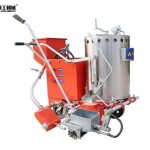Thermoplastic striping machine is an essential piece of equipment used in road marking, parking lot striping, and other surface marking applications. This machine is specifically designed for applying thermoplastic paint, a durable, high-quality material that is widely used for creating long-lasting road markings, pedestrian crossings, and other safety markings. Thermoplastic striping equipment heat the thermoplastic material to a molten state and then apply it to the surface using specialized spray nozzles or extrusion systems. With the increasing demand for high-performance, long-lasting road markings, thermoplastic striping equipment has become indispensable in modern surface marking industries.
How Does the Thermoplastic Striping Machine Work?
- Thermoplastic road marking machines function by using a heated tank to melt solid thermoplastic paint, which is then applied to the road surface. The process is as follows:
- Heating the Thermoplastic Paint: The machine has a heating system that melts the solid thermoplastic paint into a liquid form at the right temperature.
- Application Process: The molten paint is then extruded or sprayed onto the surface to form precise lines and markings.
- Drying and Cooling: Once applied, the thermoplastic material cools rapidly, solidifying to create a durable, long-lasting surface marking.
- Thermoplastic paint machines may use either airless spray or mechanical extrusion systems, depending on the model and application needs.
Advantages of Using a Thermoplastic Marking Machine
- Durability: Thermoplastic markings are highly durable and resistant to wear and tear, ensuring that markings stay visible for extended periods.
- Quick Drying: The rapid cooling and solidifying process of thermoplastic material allows road markings to be ready for use quickly.
- High Visibility: Thermoplastic markings are often brighter and more reflective, improving visibility and safety for drivers and pedestrians.
- Cost-Effectiveness: Though initial investment costs may be higher, the long lifespan and low maintenance requirements of thermoplastic markings make them a cost-effective solution in the long term.



